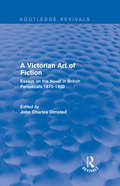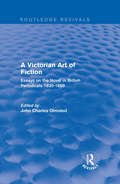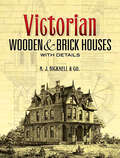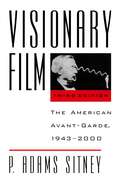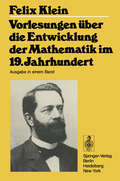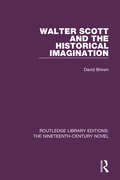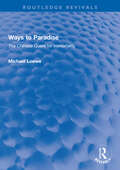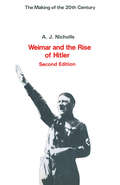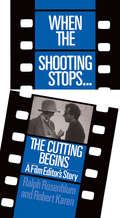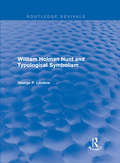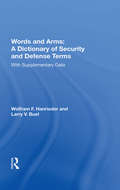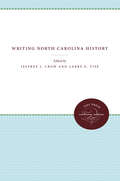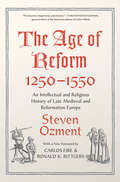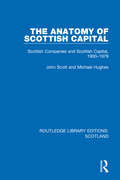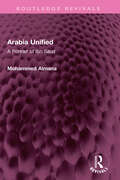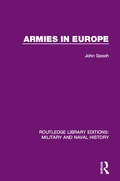- Table View
- List View
A Victorian Art of Fiction: Essays on the Novel in British Periodicals 1870-1900
by John Charles OlmstedFirst published in 1979, this collection of thirty-nine essays on the novel drawn from seventeen periodicals demonstrates the primary concerns of those discussing the nature and purpose of prose fiction in the period from 1870 to 1900. The essays reflect what was thought and said about the art of fiction and reveal what journalists of these periodicals thought were the most urgent critical concerns facing the working reviewer. Including an introduction which assesses the issues raised by the best periodicals at the time, this anthology is designed to provide students of Victorian fiction and critical theory with a collection of essays on the art of fiction in a convenient and durable form.
A Victorian Art of Fiction: Essays on the Novel in British Periodicals 1870-1900
by William H. Swatos Jr.First published in 1979, this collection of thirty-nine essays on the novel drawn from seventeen periodicals demonstrates the primary concerns of those discussing the nature and purpose of prose fiction in the period from 1870 to 1900. The essays reflect what was thought and said about the art of fiction and reveal what journalists of these periodicals thought were the most urgent critical concerns facing the working reviewer. Including an introduction which assesses the issues raised by the best periodicals at the time, this anthology is designed to provide students of Victorian fiction and critical theory with a collection of essays on the art of fiction in a convenient and durable form.
A Victorian Art of Fiction: Essays on the Novel in British Periodicals 1830-1850
by John Charles OlmstedFirst published in 1979, this collection of sixty-three essays on the novel drawn from ten periodicals demonstrates the primary concerns of those discussing the nature and purpose of prose fiction in the period from 1830 to 1850. The essays reflect what was thought and said about the art of fiction and reveal what journalists of these periodicals thought were the most urgent critical concerns facing the working reviewer. Including an introduction which assesses the issues raised by the best periodicals at the time, this anthology is designed to provide students of Victorian fiction and critical theory with a collection of essays on the art of fiction in a convenient and durable form.
A Victorian Art of Fiction: Essays on the Novel in British Periodicals 1830-1850
by John Charles OlmstedFirst published in 1979, this collection of sixty-three essays on the novel drawn from ten periodicals demonstrates the primary concerns of those discussing the nature and purpose of prose fiction in the period from 1830 to 1850. The essays reflect what was thought and said about the art of fiction and reveal what journalists of these periodicals thought were the most urgent critical concerns facing the working reviewer. Including an introduction which assesses the issues raised by the best periodicals at the time, this anthology is designed to provide students of Victorian fiction and critical theory with a collection of essays on the art of fiction in a convenient and durable form.
Victorian Wooden and Brick Houses with Details
by A. J. Bicknell Co.This vintage volume offers a treasure trove of floor plans, elevations, and details of residences and public buildings. Artists, architects, and historians alike will find it an endless source of inspiration.Featured buildings include villas, cottages, and farm houses as well as churches, schools, banks, and many other structures. Eighty-one remarkably detailed illustrations capture the elaborate, distinctive beauty of Victorian-era cornices, staircases, gables, verandas, doors, dormers, and other architectural elements. In addition, a fascinating "Specifications" section highlights construction guidelines for masons, bricklayers, and carpenters.
Visionary Film: The American Avant-Garde, 1943-2000
by P. Adams SitneyCritics hailed previous editions of Visionary Film as the most complete work written on the exciting, often puzzling, and always controversial genre of American avant-garde film. This book has remained the standard text on American avant-garde film since the publication of its first edition in 1974. Now P. Adams Sitney has once again revised and updated this classic work, restoring a chapter on the films of Gregory J. Markopoulos and bringing his discussion of the principal genres and major filmmakers up to the year 2000.
Vorlesungen über die Entwicklung der Mathematik im 19. Jahrhundert: Teil I (Grundlehren der mathematischen Wissenschaften #24/25)
by Felix KleinWalter Scott and the Historical Imagination (Routledge Library Editions: The Nineteenth-Century Novel)
by David BrownFirst published in 1979. This study explores the main critical issues that arise out of a modern reading of Scott’s work, and treats the major novels in detail. It tackles the questions of Scott’s place in literary history and his problems in pioneering the historical novel. As well as examining the greater novels of the Scottish series, the author also deals with the relation between historical fiction and reality, with reference to the Waverley Novels, and Scott’s own attitude to history. Also discussed are some of the possible reasons for Scott’s failure to depict conflicts in his contemporary society. This book would be of interest to students of literature.
Walter Scott and the Historical Imagination (Routledge Library Editions: The Nineteenth-Century Novel)
by David BrownFirst published in 1979. This study explores the main critical issues that arise out of a modern reading of Scott’s work, and treats the major novels in detail. It tackles the questions of Scott’s place in literary history and his problems in pioneering the historical novel. As well as examining the greater novels of the Scottish series, the author also deals with the relation between historical fiction and reality, with reference to the Waverley Novels, and Scott’s own attitude to history. Also discussed are some of the possible reasons for Scott’s failure to depict conflicts in his contemporary society. This book would be of interest to students of literature.
Ways to Paradise: The Chinese Quest for Immortality (Routledge Revivals)
by Michael LoeweFirst published in 1979, in Ways to Paradise Michael Loewe, an internationally recognised authority on Han China, assesses a wealth of an archaeological evidence in an attempt to uncover the attitudes of the pre-Buddhist Chinese to matters relating to death and hereafter. Dr Loewe examines in particular three major subjects of Han art and iconography: a recently found silk painting from Central China dating from around 168 BC; the numerous bronze mirrors of the so-called TLV pattern that came into fashion at the beginning of the Christian era, and which are especially rich in cosmological symbolism; and the representations of the Queen Mother of the West which appear as a leading motif of Chinese art from perhaps a century later. These Dr Loewe sets within a framework of contemporary literature and historical incident to create a wonderfully vivid picture of religious life and thought in this early and fascinating period of Chinese history which was to contribute so much to later developments in Far Eastern Philosophy, religion and art.
Ways to Paradise: The Chinese Quest for Immortality (Routledge Revivals)
by Michael LoeweFirst published in 1979, in Ways to Paradise Michael Loewe, an internationally recognised authority on Han China, assesses a wealth of an archaeological evidence in an attempt to uncover the attitudes of the pre-Buddhist Chinese to matters relating to death and hereafter. Dr Loewe examines in particular three major subjects of Han art and iconography: a recently found silk painting from Central China dating from around 168 BC; the numerous bronze mirrors of the so-called TLV pattern that came into fashion at the beginning of the Christian era, and which are especially rich in cosmological symbolism; and the representations of the Queen Mother of the West which appear as a leading motif of Chinese art from perhaps a century later. These Dr Loewe sets within a framework of contemporary literature and historical incident to create a wonderfully vivid picture of religious life and thought in this early and fascinating period of Chinese history which was to contribute so much to later developments in Far Eastern Philosophy, religion and art.
Weimar and the Rise of Hitler (The\making Of The Twentieth Century Ser.)
by A J Nicholls Georgios KolliarakisWhen The Shooting Stops ... The Cutting Begins: A Film Editor's Story
by Ralph Rosenblum Robert KarenThe story of one of the most important and least-understood jobs in moviemaking-film editing-is here told by one of the wizards, Ralph Rosenblum, whose credentials include six Woody Allen films, as well as The Pawnbroker, The Producers, and Goodbye, Columbus. Rosenblum and journalist Robert Karen have written both a history of the profession and a personal account, a highly entertaining, instructive, and revelatory book that will make any reader a more aware movie-viewer.
William Holman Hunt and Typological Symbolism (Routledge Revivals)
by George P. LandowIn this study, first published in 1979, Landow contends that Hunt’s version of Pre-Raphaelitism concerned itself primarily with an elaborate system of painterly symbolism rather than with a photographic realism as has been usually supposed. Like Ruskin, Hunt believed that a symbolism based on scriptural typology – the method of finding anticipations of Christ in Hebrew history – could produce an ideal art that would solve the problems of Victorian painting. According to Hunt, this elaborate symbolism could simultaneously avoid the dangers of materialism inherent in a realistic style, the dead conventionalism of academic art, and the sentimentality of much contemporary painting. George Landow examines Hunt’s work in the context of this argument and, drawing on much unknown or previously inaccessible material, shows how he used texts, frames, and symbols to create a complex art of mediation that became increasingly visionary as the artist grew older. This book is ideal for students of art history.
William Holman Hunt and Typological Symbolism (Routledge Revivals)
by George P. LandowIn this study, first published in 1979, Landow contends that Hunt’s version of Pre-Raphaelitism concerned itself primarily with an elaborate system of painterly symbolism rather than with a photographic realism as has been usually supposed. Like Ruskin, Hunt believed that a symbolism based on scriptural typology – the method of finding anticipations of Christ in Hebrew history – could produce an ideal art that would solve the problems of Victorian painting. According to Hunt, this elaborate symbolism could simultaneously avoid the dangers of materialism inherent in a realistic style, the dead conventionalism of academic art, and the sentimentality of much contemporary painting. George Landow examines Hunt’s work in the context of this argument and, drawing on much unknown or previously inaccessible material, shows how he used texts, frames, and symbols to create a complex art of mediation that became increasingly visionary as the artist grew older. This book is ideal for students of art history.
Words And Arms: With Supplementary Data
by Wolfram F HanriederThis comprehensive dictionary of terms frequently used in discussions of national security and defense policy contains approximately 800 entries on weapons systems, strategy concepts, military organization, and related items. Part 2 presents a more extensive treatment of such concepts as strategic force doctrine and deployment, Soviet and U.S. poli
Words And Arms: With Supplementary Data
by Wolfram F HanriederThis comprehensive dictionary of terms frequently used in discussions of national security and defense policy contains approximately 800 entries on weapons systems, strategy concepts, military organization, and related items. Part 2 presents a more extensive treatment of such concepts as strategic force doctrine and deployment, Soviet and U.S. poli
Writing North Carolina History
by Jeffrey J. Crow and Larry E. TiseWriting North Carolina History is the first book to assess fully the historical literature of North Carolina. It combines the talents and insights of eight noted scholars of state and southern history: William S. Powell, Alan D. Watson, Robert M. Calhoon, Harry L. Watson, Sarah M. Lemmon, and H. G. Jones. Their essays are arranged in chronological order from the founding of the first English colony in North America in 1585 to the present.Traditionally North Carolina has not received the same scholarly attention as Virginia and South Carolina, despite the excellent resources available on Tar Heel history. This study, derived from a symposium sponsored by the North Carolina Division of Archives and History in 1977, asks questions and describes methodologies needed to redress past neglect. Besides providing a comprehensive evaluation of what has been written about North Carolina, the essayists offer perspectives on how historians have interpreted the state's history and what directions future historians need to take. Particularly important, the book provides a bibliography and suggests opportunities for future historical investigation by discussing topics, themes, and source materials that remain untapped or underused.North Carolina's unique and colorful culture, folklore, geography, politics, and growth demand new and creative historical analysis. Collectively the authors and editors of Writing North Carolina History offer a welcome, necessary guide to the study of Tar Heel history.Originally published in 1979.A UNC Press Enduring Edition -- UNC Press Enduring Editions use the latest in digital technology to make available again books from our distinguished backlist that were previously out of print. These editions are published unaltered from the original, and are presented in affordable paperback formats, bringing readers both historical and cultural value.
The Age of Reform, 1250-1550: An Intellectual and Religious History of Late Medieval and Reformation Europe
by Steven OzmentCelebrating the fortieth anniversary of this seminal book, this new edition includes an illuminating foreword by Carlos Eire and Ronald K. Rittges The seeds of the swift and sweeping religious movement that reshaped European thought in the 1500s were sown in the late Middle Ages. In this book, Steven Ozment traces the growth and dissemination of dissenting intellectual trends through three centuries to their explosive burgeoning in the Reformations—both Protestant and Catholic—of the sixteenth century. He elucidates with great clarity the complex philosophical and theological issues that inspired antagonistic schools, traditions, and movements from Aquinas to Calvin. This masterly synthesis of the intellectual and religious history of the period illuminates the impact of late medieval ideas on early modern society. With a new foreword by Carlos Eire and Ronald K. Rittgers, this modern classic is ripe for rediscovery by a new generation of students and scholars.
The Anatomy of Scottish Capital: Scottish Companies and Scottish Capital, 1900-1979 (Routledge Library Editions: Scotland #27)
by John Scott Michael HughesOriginally published in 1980, this book gives a concrete description of the development of Scottish companies and Scottish capital through the 20th Century, based on empirical study. The study begins with the major companies of 1904-5 and examines their history and subsequent development. The top companies in a number of periods are also examined and the study concludes with an investigation of the major companies of 1973-4 and their response to the (then) recent oil developments. The book uses both detailed company histories and broad historical interpretations as sources drawing the data together into chronologically ordered sections. Its focus is on the companies and people which make up the system of Scottish capital, seen as a relatively distinct system with its own characteristics and its own pattern of development within the British system.
The Anatomy of Scottish Capital: Scottish Companies and Scottish Capital, 1900-1979 (Routledge Library Editions: Scotland #27)
by John Scott Michael HughesOriginally published in 1980, this book gives a concrete description of the development of Scottish companies and Scottish capital through the 20th Century, based on empirical study. The study begins with the major companies of 1904-5 and examines their history and subsequent development. The top companies in a number of periods are also examined and the study concludes with an investigation of the major companies of 1973-4 and their response to the (then) recent oil developments. The book uses both detailed company histories and broad historical interpretations as sources drawing the data together into chronologically ordered sections. Its focus is on the companies and people which make up the system of Scottish capital, seen as a relatively distinct system with its own characteristics and its own pattern of development within the British system.
Arabia Unified: A Portrait of Ibn Saud (Routledge Revivals)
by Mohammed AlmanaFirst Published in 1980 Arabia Unified presents an insider’s view of Saudi Arabia’s history and the remarkable career of its founder. The book covers the capture of Riyadh from the Saud family’s greatest rivals, the Rashid’s, and the eventual defeat of Al Rashid at the battle of Rowdhat Muhanna; the elimination of Ibn Saud’s most implacable enemies; the incorporation of the provinces of Asir and Hejaz into the kingdom; and the rise, rebellion, and eventual defeat of the puritanical Ikhwan tribesmen. Author describes life with the King’s Bedouin warriors and the intricacies of the Arabian tribal system; the confrontation with the Imam Yahya of the Yemen; and finally, the start of the oil exploration which was to transform the country. The author concludes with his own account of the King’s character and achievements. Full of humor, anecdote and reminiscence, an accurate and personal record, this book is essential reading for all who wish to know about the history of Saudi Arabia.
Arabia Unified: A Portrait of Ibn Saud (Routledge Revivals)
by Mohammed AlmanaFirst Published in 1980 Arabia Unified presents an insider’s view of Saudi Arabia’s history and the remarkable career of its founder. The book covers the capture of Riyadh from the Saud family’s greatest rivals, the Rashid’s, and the eventual defeat of Al Rashid at the battle of Rowdhat Muhanna; the elimination of Ibn Saud’s most implacable enemies; the incorporation of the provinces of Asir and Hejaz into the kingdom; and the rise, rebellion, and eventual defeat of the puritanical Ikhwan tribesmen. Author describes life with the King’s Bedouin warriors and the intricacies of the Arabian tribal system; the confrontation with the Imam Yahya of the Yemen; and finally, the start of the oil exploration which was to transform the country. The author concludes with his own account of the King’s character and achievements. Full of humor, anecdote and reminiscence, an accurate and personal record, this book is essential reading for all who wish to know about the history of Saudi Arabia.
Armies in Europe (Routledge Library Editions: Military and Naval History)
by John GoochThis book, originally published in 1980, is a study of the nature and purposes of peace-time military organization in Europe, and of the characteristics and outcome of the major wars fought during these years. It charts the rise of mass armies and the role of conscription as a socializing agent and a military instrument, as well as discussing the growing involvement of society in war both as agent and target of military activity, the mounting effort required of a society in order to ahcieve victory, culminating in the ‘Total War’ of 1939-45. Among other subjects explored are the development of war economies, the genesis and significance of war aims, the importance of social cohesion in modern war and the impact of technology.
Armies in Europe (Routledge Library Editions: Military and Naval History)
by John GoochThis book, originally published in 1980, is a study of the nature and purposes of peace-time military organization in Europe, and of the characteristics and outcome of the major wars fought during these years. It charts the rise of mass armies and the role of conscription as a socializing agent and a military instrument, as well as discussing the growing involvement of society in war both as agent and target of military activity, the mounting effort required of a society in order to ahcieve victory, culminating in the ‘Total War’ of 1939-45. Among other subjects explored are the development of war economies, the genesis and significance of war aims, the importance of social cohesion in modern war and the impact of technology.
